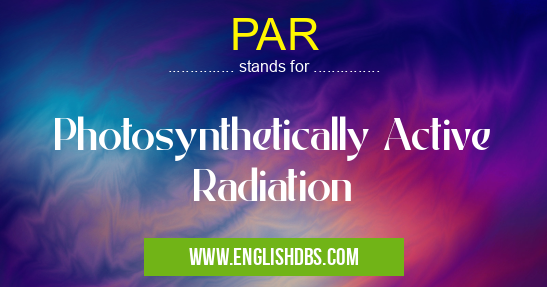What does PAR mean in BOTANY
Photosynthesis is the basis of life on Earth, however without an energy source this process cannot occur. This energy source most often comes from light, which is known as Photosynthetically Active Radiation (PAR). PAR is a measure of the amount of radiation that is available from the sun for photosynthesis, allowing plants to absorb and convert energy for their survival.

PAR meaning in Botany in Academic & Science
PAR mostly used in an acronym Botany in Category Academic & Science that means Photosynthetically Active Radiation
Shorthand: PAR,
Full Form: Photosynthetically Active Radiation
For more information of "Photosynthetically Active Radiation", see the section below.
Definition
Photosynthetically Active Radiation (PAR) is measured in units of photons per square meter per second (µmol m-2 s-1) and ranges between 400 and 700 nm in wavelength. PAR can be further divided into two categories; the UV-A range of 315-400 nm and UV-B range 280-315 nm. The UV radiation can cause damage to certain plants, while PAR allows photosynthesis to take place without any adverse effects.
Importance
The availability of PAR has a huge influence on the nature and amount of photosynthetic activity that takes place in an ecosystem. Without sufficient levels of PAR, biological processes will be slowed or stopped entirely which may lead to reduced productivity or biomass over time. Therefore, it is important for both agricultural practices and terrestrial ecosystems to monitor the levels and availability of PAR in order to ensure that they remain healthy and productive.
Essential Questions and Answers on Photosynthetically Active Radiation in "SCIENCE»BOTANY"
What is the meaning of PAR?
Photosynthetically Active Radiation (PAR) is the range of light frequencies necessary for photosynthesis in plants and other photosynthetic organisms. This light is generally considered to be in the 400-700 nanometer range of the electromagnetic spectrum.
How does PAR affect plant growth?
The energy from PAR is critical for plant growth. It increases photosynthesis, which produces energy that helps drive processes such as respiration, transpiration, and germination of seeds. Additionally, it affects photomorphogenesis, the process by which a plant adjusts its shape and size to changes in light intensity and quality.
What is the ideal intensity of PAR for optimal plant growth?
The ideal intensity of PAR for optimal plant growth will vary depending on the species or cultivar being grown. Generally speaking, a light intensity ranging from 500-800 µmol·mâ»Â²Â·sâ»Â¹ is suitable for most high-light crops like tomatoes or peppers. Low-light crops such as leafy greens require less intense levels of light (200-400 µmol·mâ»Â²Â·sâ»Â¹).
How do you measure PAR?
There are several ways to measure PAR, including using a quantum sensor, photodiode array spectrophotometer or integrating sphere spectrophotometer. Quantum sensors measure every photon individually while photodiode arrays measure an area all at once to create an average value. Integrating spheres provide more detailed information about individual wavelengths within a specific range.
Are all lightsources suitable for providing adequate PAR?
Not all lightsources are appropriate for providing adequate PAR to plants. For example, common tungsten and fluorescent bulbs emit only small amounts ofPAR when compared with specialized horticultural grow lamps such as LED (Light Emitting Diode) fixtures or HIDs (High Intensity Discharge). These are specifically designed to output higher amounts of useful light frequencies needed for optimum yield production and quality in plants.
Does temperature affect PAR readings?
Yes, temperature can affect the accuracy of a PAR reading if not taken into account when measuring it. Higher temperatures will cause increased air movement which can scatter some wavelengths thereby reducing the amount detected by a meter or measuring device. That's why ambient temperature should always be taken into account when conducting measurements with a quantum sensor or other devices designed to measure PAR.
Is UV included in PAR measurement?
UV radiation falls within the spectrum between 400nm - 700 nm used to calculate Photosynthetically Active Radiation (PAR), however since UV can harm plants it's excluded from measurements because its presence varies greatly depending on factors like latitude and season.
Final Words:
In conclusion, Photosynthetically Active Radiation (PAR) plays an essential role in enabling organisms such as plants to carry out their vital roles within our ecosystems. Its importance should not be overlooked as its availability can significantly affect both our wild spaces and agricultural settings alike. By monitoring levels of PAR we are able to guarantee the healthiness of these environments moving forward into the future.
PAR also stands for: |
|
| All stands for PAR |
